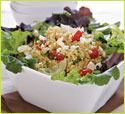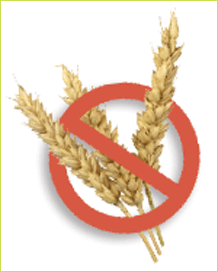As many as one out of every 133 Americans has celiac disease. Are you one of them?
About three million Americans suffer from celiac disease, but only 3 percent actually know they have it because symptoms vary widely. If left untreated, celiac disease can lead to a variety of health problems, including anemia, osteoporosis, problems in pregnancy, and chronic stomach problems. In more severe cases, celiac disease can cause malnutrition.
What is celiac disease?
Celiac disease is a digestive disorder that prevents nutrients from being absorbed in the small intestine. When people with celiac disease eat foods that have gluten—basically anything with wheat, barley, or rye—their immune system responds by damaging the lining of the small intestine. This results in malnourishment because the body can't absorb any nutrients from food. Celiac disease is especially serious for children, who need proper nutrition for healthy growth and development.
It's not something you can "catch"
Research has shown that celiac disease is inherited, which means you're born with it. However, a person can live for a long time with no ill effects from the disease. Usually there's some sort of trigger—an environmental, emotional, or physical event in a person's life—that causes celiac disease to "wake up" and start wreaking havoc in their body.
Symptoms and diagnosis
Some of the more common symptoms of celiac disease include bloating, gas, and diarrhea. But symptoms can include constipation, fatigue, itchy skin rash, joint pain, infertility, headaches, depression, irritability, discolored teeth, pale mouth sores, and delayed growth in children. Symptoms can vary widely from person to person, and some people with celiac disease have no symptoms at all.
Many of these symptoms mimic those of other diseases, which makes diagnosing celiac disease a challenge for your doctor. Once suspected, celiac disease can be confirmed through blood tests and may require an examination of the lining of the small intestine.
Treatment: Go gluten-free
There is no cure for celiac disease, but you can effectively manage it by cutting out all forms of gluten from your diet. However, you should see your doctor for a diagnosis before starting a gluten-free diet for symptoms of celiac disease.
What is gluten?
Gluten is the protein found in wheat, rye, and barley. While many foods containing gluten are obvious—breads, pasta, and other baked goods—others are harder to find. Here are some unsuspecting places where you might find gluten: Popsicles, processed lunch meats, soy sauce, beer, some soy milks and rice milks, prescription and over-the-counter drugs, some vitamins, and even glue on envelopes. Also, beware of gluten disguised as modified food starch, MSG, lecithin, textured vegetable protein, emulsifiers, and caramel coloring.
Gluten-free cooking
Following a gluten-free diet requires you to be a bit of a food detective, but once you know what to avoid, you can prepare all kinds of delicious meals. A good gluten-free cookbook can help you find the right proportions of flours, starches, and other ingredients for a huge variety of culinary creations.
Here's a light summertime menu to help you get started—all of the ingredients should be available at most grocery stores. You can add your choice of grilled meat, chicken, or fish if you like, but the salad alone provides a complete meal. Enjoy!
 Quinoa Salad with Lemon Tahini
Quinoa Salad with Lemon Tahini
Salad:
1 cup dry quinoa
2 cups water or broth
1 15-oz. can garbanzo beans, drained and rinsed
½ cup cucumber, diced
1 cup cherry tomatoes, sliced in half
3 Tbsp. fresh parsley, chopped
Mixed salad greens
2 Tbsp. feta cheese, crumbled (optional)
Dressing:
1 garlic clove, minced
¼ cup tahini (sesame seed paste)
Zest of 1 lemon
¼ cup fresh lemon juice
2 Tbsp. extra-virgin olive oil
2 Tbsp. hot water
Pinch sea salt
In a medium saucepan, combine quinoa and water or broth and bring to a boil. Reduce heat and simmer about 15 minutes until quinoa fluffs up. Meanwhile, whisk together garlic, tahini, lemon zest and juice, olive oil, and salt. Add hot water to thin as necessary. Set aside.
Toss cooled quinoa, garbanzo beans, cucumber, tomato, and parsley with the dressing. Serve over mixed salad greens with feta cheese on top. Makes 4 servings.
 Dessert Crêpes with Summer Berries
Dessert Crêpes with Summer Berries
Crêpes:
3 eggs
1¼ cup low-fat milk
¼ tsp. gluten-free vanilla*
½ cup brown rice flour
3 Tbsp. potato starch
1½ Tbsp. tapioca starch
1 tsp. sugar
¼ tsp. salt
Fillings & Toppings:
2 cups fresh blueberries,
raspberries, or strawberries
100% pure maple syrup*
Gluten-free chocolate syrup*
Gluten-free powdered sugar*
Gluten-free vanilla frozen yogurt*
Beat eggs well, add milk and vanilla. In a separate bowl, combine rice flour, tapioca starch, potato starch, sugar, and salt. Add to egg mixture and whisk until smooth. Heat skillet to medium-high and grease with melted butter or cooking spray. Add ¼ cup of batter and swirl to cover pan. Cook one minute or until golden brown, then flip. Add fresh berries and roll or fold inside crêpe. Dust with powdered sugar, and serve with desired toppings. Makes 10-12 crêpes.
*Many varieties of these products are gluten-free, but not all. Be sure to check the ingredient list carefully.





